When I posted the graphs based on the ONS data for week 10, lots of people (mainly on Twitter, not here) said, ‘You have to wait a couple of weeks, then you’ll see something that will make you wet yourself in fear’.
Well, we’ve now got the graphs for three weeks later than that first batch, so let’s see if there’s anything showing yet. (If you saw my earlier posts you may get a sense of deja vu reading this one.)
The latest ONS data is here.
The first batch of graphs were done by a reader of this blog, David Clark, who does this sort of thing for a living.
Firstly, here’s a graph of the latest all-death numbers in England and Wales, up to 27 March (end of week 13). Bit of an uptick in week 13 after a downward turn the week before. Still no World War 3 though. (Click to enlarge.)
Let’s now break it down by age. Here’s the week 13 graph of the deaths of people aged 65-74, up to March 27, 2020 (England and Wales). It’s completely normal. (Click to enlarge.)
Now a graph of the deaths of people aged 75-84, up to March 27, 2020 (Eng & Wales). Bit of an increase in week 13 after a dip in week 12. Still in the normal range. (Click to enlarge.)
A graph of the deaths of people aged 85 and over, up to March 27, 2020 (Eng & Wales). An increase in week 13 after a dip of roughly the same size in week 12. Still in the normal range. (Click to enlarge.)
Now a graph of the all-death numbers in England and Wales, stratified by age group, up to March 27, 2020. All are in the normal range. (Click to enlarge.)
Now, moving on from the all-death graphs, we have a graph of the respiratory death figures from the ONS figures for England and Wales up to March 27, 2020 (end of week 13).
BTW the red dots indicate what the ONS is calling ‘Covid-19 deaths’. This is useless category that isn’t worth paying much attention to, I’ll explain why in more detail in a later post. (I have now got some terse but useful info out of the ONS). All you need to know now is that the ONS’s Covid-19 deaths are neither a subset of respiratory deaths nor additional to it, but they will partly overlap. Some C19 deaths will be respiratory, and included in that set, but we don’t know how many.
What’s astonishing about this graph is that despite there being 539 deaths in the Covid-19 category for week 13, the respiratory deaths total for that week is totally normal. There are two possibilities (maybe more) that could explain this.
One is the fact that the Covid-19 category includes people who die with Covid-19, but not necessarily of Covid-19. Unfortunately the ONS doesn’t produce a breakdown of the numbers who had as it as the cause of death on their certificate, and the numbers who just had it mentioned on their certificate (as Covid-19 is a ‘notifiable’ disease whoever fills out the certificate has to note if the person had, or was suspected of having, Covid-19). So we don’t know how much of an effect this has, but I would be surprised if it has no effect.
The second possibility is that many of the people who are dying of Covid-19 are people who would have died soon anyway, or at least, they’re people who are vulnerable to any viral infection (even a bad cold can finish off someone who is near death and whose immune system is shot). It’s very clear now that Covid-19 kills mainly (not exclusively, but mainly) elderly people who are medically vulnerable.
Now here are some more graphs done by Robert Watson, a retired Professor.
First up is a graph of weekly respiratory deaths in England and Wales from the ONS figures, up to 27 March again, with the prior five-year average in there for context (the blue line is 2020, and the orange line is the five-year average).
Week 13 is the only week of the year so far where there have been more (slightly more) respiratory deaths than the five-year average.
(Note that this is not cumulative, the blue line being higher than the orange line in week 13 does not indicate that 2020 has ‘caught up’ the five-year average in total deaths, just that that week 2020 was higher.)
And now here are the respiratory figures presented as a cumulative graph. Again, it’s for England and Wales up to end of week 13 (27-3-20), with the prior five-year average (orange line) in there for context.
The 2020 total up to the end of week 13: 22 877 respiratory deaths.
The 5-year average at the end of week 13: 26 161 respiratory deaths.
This means that up to 27 March there have been 3284 less respiratory deaths in 2020 than the five-year average.
(Before you ask whether ‘respiratory deaths’ includes Covid-19-related respiratory deaths, I have asked the ONS, and the answer seems to be yes, although everything with the ONS is as clear as mud, they don’t explain things properly.)
Even I am astonished by these graphs. I was expecting to see something in the graphs by week 13, even if I wasn’t expecting anything scary. But there’s just nothing. And you can’t say the lockdown caused this, because the UK lockdown had only been going for four days by this time. We’ve locked down the country for a supposed mass killer that still isn’t visible in the stats even after the lockdown was declared. We locked the country down for something that at the time only existed in Neil Ferguson’s dodgy computer models.
Thanks again to David and Robert for putting the work in. Once again I say: why isn’t the ONS doing graphs like these?
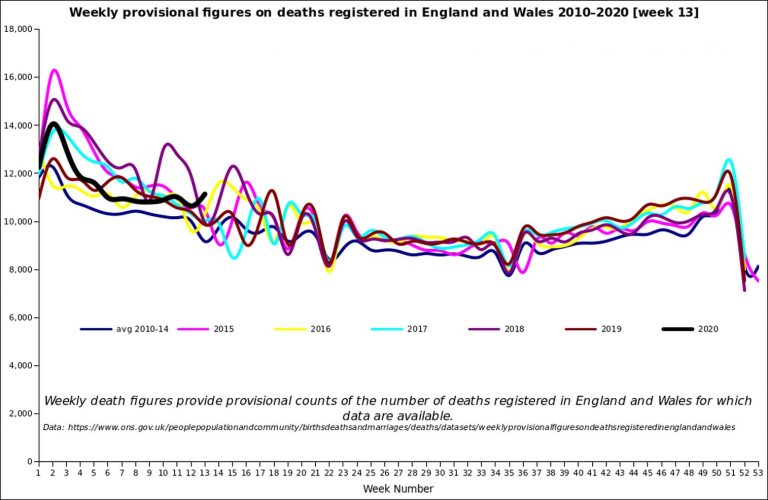

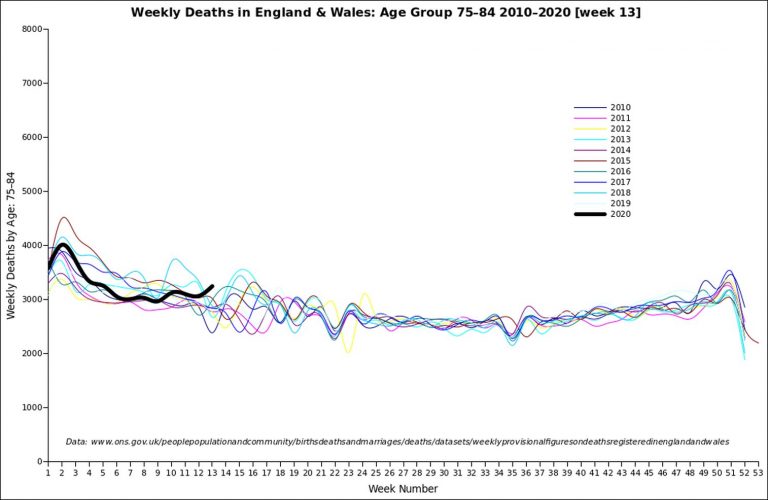
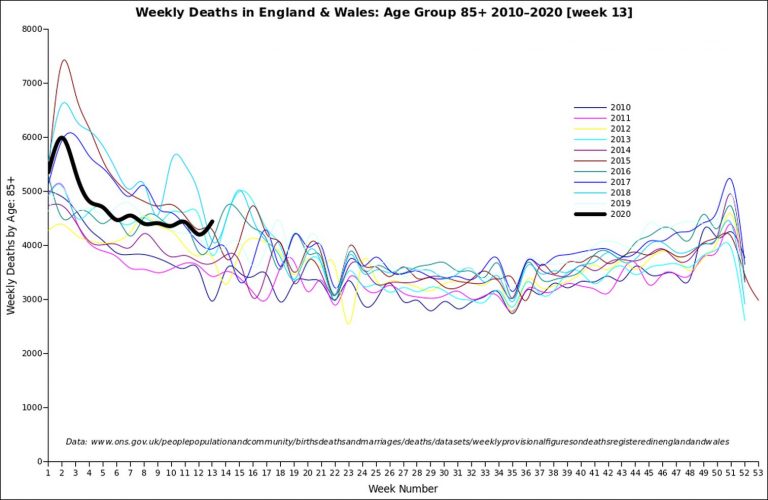


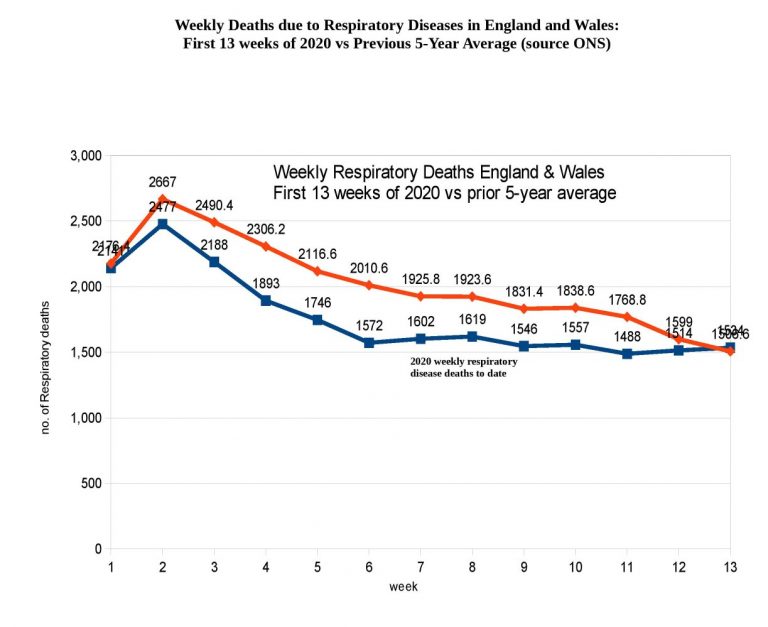
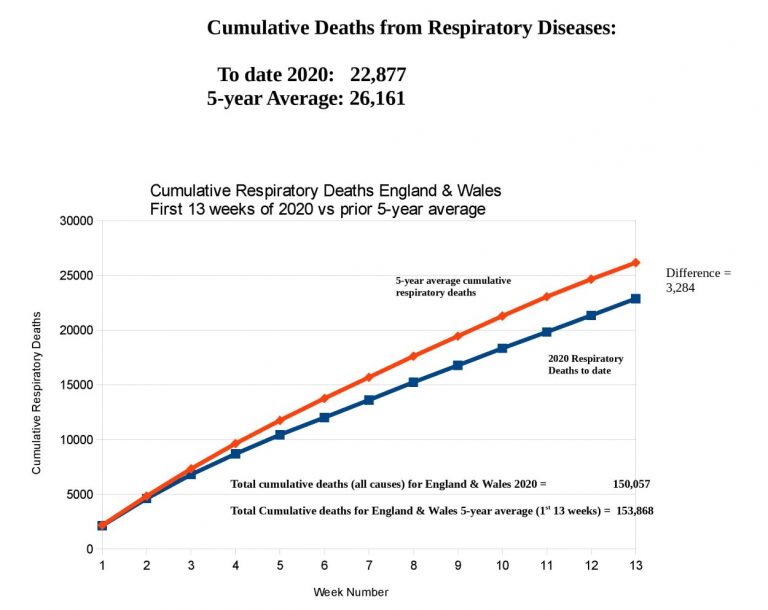
34 thoughts on “Week 13 ONS graphs, still nothing”
Time is running out for the jury on this one. Building seven etc.
Big thanks to all involved for doing the hard work of getting real data into an understandable form.
One caution:
“BTW the red dots indicate what the ONS is calling ‘Covid-19 deaths’. This is useless category that isn’t worth paying much attention to …”
But that is the ONLY data that gets trumpeted in the media. It makes people think that the prophesied exponential growth in mortality is hitting.
A slightly different take on the same phenomena and interesting info on blood groups.
https://underdogsbiteupwards.wordpress.com/2020/04/08/a-new-theory/
It’s not really very plausible.
Even if the virus can get into RBCs and release heme, haemolysis sufficient to result in noteworthy lung injury would not go unnoticed. The resulting anaemia would be exacerbating symptoms (shortness of breath, fatigue) long before it became a mechanism of injury. The ICUs do check patients RBC, hemoglobin, hematocrit etc, at least daily. They would be transfusing, not just ventilating, such patients.
The entire hydroxychloroquine story really needs to go away and die until someone has done a proper trial. Unfortunately, conducting that trial may already be compromised by the publicity and the widespread availability of hydroxychloroquine.
There was one fatally-flawed study (incomparable groups, skew in missing data between groups, biased imputation of missing data) conducted, on a clinically meaningless endpoint (less virus up the schnozz). For good measure, the only death and all ICU admissions occurred in the treated group!
It would be so easy to conduct a study well-designed and large enough to find out if any particular product affects a clinically meaningful endpoint (hospitalization or death). There are thousands of new patients every day, there would be no shortage of volunteers, and the timescale of the study is limited by the fact that you reach the endpoint (recovery or death) within at most a few weeks of infection.
We could be doing the world’s cheapest and fastest Phase 3 trials right now but instead have to waste time rebutting baseless chloroquine claims.
Thanks Nessimmersion – A very interesting read, especially if you include all the links.
I can’t find it now (didn’t bookmark), but a few days ago a Canadian ICU specialist posted that his experience so far of seriously ill C-19 patients lead him to think that the ventilator was not helping and it was changes in the way the patient couldn’t process oxygen.
I had seen a reference somewhere asking if anyone had looked at data on increased risk with C-19 by blood group. The linked article in your post shows a possible connection in the same way that blood group appears to affect propensity to severe Malaria. All very interesting stuff.
I am a Brit, but it’s sad to see how those infected by Trump Derangement Syndrome (TDS) in the USA have reacted to his Tweet on subject of the use of Hydroxychloroquine with Azithromicin as a possible help. One Dem governor has not only banned its use in the fight to save lives from C-19, but warned any doctor using it that they will face prosecution in that state. Amazing. Now this hypothesis gives a reason why it might work by acting in the same way as it does against Malaria.
Maybe nothing will come of all this – since the whole mess is too political now.
Oh! I am “O” blood group.
Thanks Hector. Despite the expected increase in the last reported week, we are also running at MINUS 3,811 total deaths versus the preceding 5-year average: I prefer binary numbers that are not subject to value judgements, and while we might expect fewer RTA deaths, it’s possible there will be an increase in other mortality rates. There will be “catch-up” fatalities (deaths that didn’t occur as per normal from influenza in jan and feb) as well as “pull-forward” fatalities (deaths that will have been brought forward a few weeks by c19), but overall it doesn’t look like it’s going to have been a bumper year to be an undertaker, and they are no doubt expecting a quieter than normal summer.
I noticed an interesting bit on the Beeb news during the small hours (I don’t sleep well at the best of times, and as for now – well, I’m sure you can guess). They told viewers that the NHS was still “Very much in business” (or words to that effect), and people with problems should still seek help. Is this a tacit admission that the “crisis” is rather overblown, and the comments from many about deserted hospitals are proof?
The only fly in this ointment is that hospitals are the very LAST place I want to visit right now, even though I’m going to have to before much longer…
Good Morning Hector,
Whilst I doubt that this news “will make you wet yourself in fear”, have you seen the new UK projections from the University of Washington? If not please see my new article:
http://GreatWhiteCon.info/2020/04/covid-19-in-the-united-kingdom/
“Deaths in the UK are forecast to peak the third week of April, with an estimated 2,932 deaths on April 17”
If I can embed an image in a comment, here’s the latest output of the UoW’s model:
http://GreatWhiteCon.info/wp-content/uploads/2020/04/IHME-DailyDeaths-2020-04-07.png
What do you make of it?
Thanks for the updates Hector, keep them coming.
A question though. You’ve said previously that you’re receiving a lot of press interest in your work but I haven’t seen anything on MSM. If anything they seem to be doubling down on the scare stories. Do you see anything more measured coming through?
Fewer RTA deaths? Won’t make a difference on this scale. The ONS figures for 2018 are the most recent available. Table 9 Leading Causes of Death. ‘Land Transport Accidents’ 3.4% (13) 1-4 year olds; 9.2% (130) 5-19 years; 7.2% (411) 20-39 years. Other age groups not big enough to count as ‘leading’
Persons
Total deaths 541,589
ICD-10 code Leading Causes Deaths Percentage of all deaths
F01, F03, G30 Dementia and Alzheimer disease 69,478 12.8
I20–I25 Ischaemic heart diseases 55,995 10.3
J40–J47 Chronic lower respiratory diseases 32,355 6
I60–I69 Cerebrovascular diseases 31,288 5.8
C33-C34 Malignant neoplasm of trachea, bronchus and lung 29,626 5.5
Trials testing 3 different treatments are currently underway.
https://www.gov.uk/government/news/worlds-largest-trial-of-potential-coronavirus-treatments-rolled-out-across-the-uk
Turns out they were mostly interested in my soap-opera science post, because that’s the sort of thing they can relate to, not actual science. A few places ran that story without crediting me, even though they got all the details from me. I sent them info about the stats, but none have talked about it.
I did have a long talk with one Daily Mail guy who ran a decent piece questioning Ferguson, but again nothing about the ONS figures:
https://www.dailymail.co.uk/news/article-8188041/Ministers-accused-treating-Doomsday-scientist-like-demigod.html
If you dispute the information given to you by ONS, why not question it? I’ve always found the team to be helpful.
Thanks again Mr.Drummond, very informative and illuminating. The pessimists do keep pushing that week back, don’t they?
Of course, you know exactly what they’ll say when this thing is over and we come rushing out of our caves, overcome with relief and gratitude, don’t you?
“Ah, the death rates have been kept down to below average, simply because we isolated you all! Be grateful to your lovely government!”
I have talked to the ONS, see my blog post today, will ask for more clarification later.
The virus death rate (accurate or not) appears to be increasing at a considerable rate. in two weeks it goes from 103 deaths to 539. If this pattern continues then does that not make the case for lockdown? I am not happy with lockdown at all as it is clearly a very damaging policy; the government has failed to handle the situation correctly so here we are.
Is it somewhat disingenuous to compare covid19, one virus, to the effects of all respiratory disease? That is not a like for like comparison since the number of people who die from every disease is a combined total and will naturally make covid19, when measured alone, less potent than perhaps it is.
People die, in very large numbers, every year, especially in winter. Why should we panic about one particular virus which is, in context, not very potent.
>in two weeks it goes from 103 deaths to 539. If this pattern continues then does that not make the case for lockdown?
I would say not in the slightest. How is hundreds of billions of pounds worth of damage to the economy, careers destroyed, businesses bust, etc. worth possibly (but probably not) extending the life of a few hundred very old people by a few months, many of whom would have died soon anyway (and half of those numbers may be people who died with C19, not from it).
>Is it somewhat disingenuous to compare covid19, one virus, to the effects of all respiratory disease?
You’re not comparing Covid-19 to respiratory deaths at all. You’re seeing if there’s a spike or a big rise in the respiratory deaths. (The red dots are in there to indicate when and to what extent the Covid-19 numbers started to rise, so we can see how this is affecting the respiratory numbers.)
With not of. The comparison of covid-19 to all respiratory deaths sets an upper bound on how many are ‘of’. Died ‘of’ covid-19 is a respiratory death in the ONS stats. Someone who dies ‘with’ covid-19 but is not included in respiratory deaths must logically have died of some other cause.
Because the NHS is designed to deal with that every winter. Therefore, that is expected. It is not designed to deal with a large influx of patients over a very short period of time at this time year. Especially the number that need ventilation and etc.
That is the entire issue and rationale for the lockdown. They want to slow the deaths down over a manageable period of time.
Well, without a lockdown it would continue to spread and that would mean the medical system would be overwhelmed with cases to treat. It isn’t a case of just treating old people. Without ventilation, lots of people in their 30’s – 50’s would die as well.
John, I’m yet to see much evidence of that. It’s true that some people in their 30s to 50s would get in a bad way, and need an ICU, but there’s no great sign of this causing mass deaths in that age range even without an ICU.
I don’t think you can assume none of these are caused by Covid. Certainly there appears confusion, possibly down to the reporting and not the medical staff. But the chart is not comparing like for like. Deaths of/with covid are a single cause, respiratory disease includes all manner of causes under that umbrella. So I don’t think that’s accurate to compare
Panic? No. Act appropriately. Yes.
Unfortuantely we didn’t. Our government put us into this position by failing to act earlier. I dont like the lockdown and I agree that it’s devastating but this is the position the Tories have put us in.
You’re not “extending” the life, you’re allowing it to run its course unimpeded by a novel virus. That life may last a few weeks, or a few years, or decades. We cannot know. I’m sure you don’t meant to but it sounds callous to just say “many of whom would have died soon anyway”.
You are also speculating that the number of those who died with it is half. Please present evidence to that end if not it serves no purpose to make that claim. Furthermore it also igores the contributory effect of covid; while it might not be directly causal in all cases, in some those that die had underlying pre existing health problems exacerbated.
As for comparisons. That is what your chart is doing. You are referring to covid deaths in the context of all respiratory diseases. How is that not a comparison?
I’m not sure what “Some C19 deaths will be respiratory, and included in that set, but we don’t know how many.” means. Covid is a respiratory disease, it’s just the ONS is separating it in these charts as its the current crisis
Perhaps I have misunderstood though, please correct me
A website run by a crank? Seriously?
If COVID-19 was the primary cause of death it will count in both the figure for COVID-19 AND as a Respiratory Death. But the COVID-19 count includes any case where COVID-19 was detected, even though that was not the primary cause.
There is an additional table in the ONS week 13 showing a comparison by date of death of the ONS registrations and the figures published on .gov by the DHSC. I am having difficulty reconciling the ONS version with what is on the .gov daily bulletin, and also with the figure published by PHE
But comparing ‘ONS deaths by actual date of death – registered by 1st April’ with the PHE ‘UK COVID-19 Deaths: UK total announced by DHSC.’ then if the PHE numbers are taken to be deaths ‘of’ and the ONS numbers are, as per their definition, deaths ‘with’ then it looks like ‘of’ is about 12% of ‘with’.
Hi Hector
Interesting charts. I’ve been doing something similar. I don’t think that many people still believe CV is “average” (at the very least, even contrarians seem to think it has the mortality rate of a severe flu) so,while it’s useful to compare this year with an average of recent years, I thought it would also be interesting to compare it to the worst flu year of the past 10 years (2017-18). I calculated the cumulative weekly deaths, starting a year before the current week (week 13) in both 2018 and 2020. The punchline is that 2019-20 so far has ~12,500 deaths fewer than 2017-18. Or, to put it another way, for the current outbreak to be as deadly as a recent bad flu year, it would have to claim an “extra” (above the corresponding weeks of 2017-18) 12,500 people.
If you’d like me to send you the chart and other details, please email me.
If this was, genuinely, the most recent data available, and we had no indication of what was to come, it could be claimed to be making a reasonable point.
But, the ONS data goes up to 27th March, when there were just under 800 deaths in the UK, cumulatively, from Covid-19. By the date of this updated version of your post, there had been 7,000 deaths in the UK that we knew of. One day later, this was at 8,000.
It is, at best, disingenuous to be making … whatever point is being made here, knowing – at the time of writing/updating – that your numbers omit 90% of the people who have died.
There have been almost 900 deaths today (or yesterday iirc) alone. This trend is rising and the science denying Cult of Hitchens at work here are putting their heads firmly int he sand. Nor are they offering workable alternatives (no one enjoys lockdown). Those deaths also do not include deaths outside of hospital and the alleged rate of infection in care homes is pretty grim reading.
These recent, misleading headline death numbers are actually spread over a longer time period. That is why we need a cool, calm look at real stats.
Plus we don’t know how many of these deaths are from Covid-19, or just with.
Deaths in care homes, 4%, at home 3%, 93% in hospital.
ONS Week 13
Deaths COVID-19 deaths
Total 11,141 539
Home 2,785 15
Hospitals 5,105 501
Hospice 504 2
Care Home 2,489 20
Other communal establishments 33 0
Elsewhere 225 1
ONS Week 13 11,141 deaths
The average of the corresponding period over the previous five years is 10,130 deaths per week.
Thus it would appear the increase of 1,011 is due to C19
HTHs
Roger A
Comments are closed.